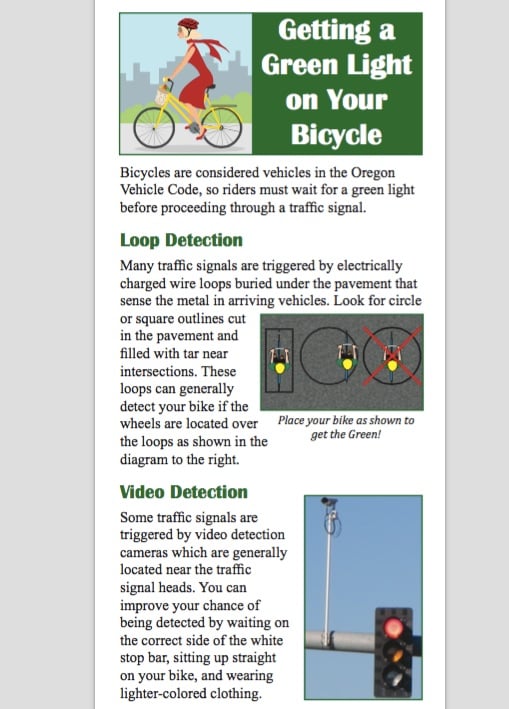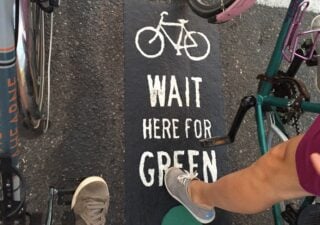The transportation agencies at the City of Portland and the State of Oregon want users of bicycles to have more success in triggering green lights at intersections.
At ODOT there’s concern that the passage of SB 533 might create dangerous situations. That bill, signed into law by Governor Kate Brown on May 21st, allows people riding bicycles and motorcycles to proceed through a red light if they’re undetected after one cycle. At PBOT, they also want to increase the number of people who know how to trigger green lights after a 2013 study showed half of Portland’s bike riders don’t know how to use the existing sensors.
To help with their education campaign, ODOT has created a new brochure (and posted it on their Bicyclist Safety webpage). ODOT Active Modes Traffic Engineer Gary Obery shared it with us yesterday.

ODOT’s worried that the new law creates unpredictable situations and that some riders will make poor decisions about when it’s safe to proceed through a red.
“With the passage of SB 533,” Obery said via email, “people on bicycles may be tempted to wait one cycle of the traffic signal and then, if they haven’t received a green, cross the intersection against a red light.” (That behavior is exactly what the law allows.) What Obery would rather have people do is get the existing signal sensor to detect their presence.
Advertisement
Obery’s concerns echo testimony given by ODOT Traffic Safety Division rep Amy Joyce to a Senate Committee during consideration of SB 533 back in April. Joyce voiced serious concerns that the law would create unpredictable and dangerous situations. Instead of going through a red, she said a better option would be to do a two-stage turn (a.k.a. a “Copenhagen Left”) or push the walk sign button.
The Governor’s Advisory Committee on Transportation Safety opposed SB 533 on similar grounds. Instead of “seeking permission to run red lights,” their rep said at that April committee hearing they preferred a complaint-driven system where people on bikes and motorcycles would call a hotline and ask ODOT to adjust sensors. “We fear inexperience and peer pressure could be fatal for bicycles and motorcycles,” the rep said.
The law passed despite these concerns and objections, so now ODOT is in education mode in advance of it becoming effective on January 1, 2016.
Their new brochure offers three main tips to “get the green”:
- Loop Detection: Many traffic signals are triggered by electrically charged wire loops buried under the pavement that sense the metal in arriving vehicles. Look for circle or square outlines cut
in the pavement and filled with tar near intersections. These loops can generally detect your bike if the wheels are located over the loops as shown in the diagram to the right.- Video Detection: Some traffic signals are triggered by video detection cameras which are generally located near the traffic signal heads. You can improve your chance of being detected by waiting on the correct side of the white stop bar, sitting up straight on your bike, and wearing lighter-colored clothing.
- Other Detection Hints: The signal does not “remember” that it detected you, so stay in the detection zone until you get a green light. If you have waited for more than two minutes, consider moving over to allow acar to move into a detection zone or go to the sidewalk and press the pedestrian push button.
As for PBOT, you might have noticed their latest education efforts out on the street. At NE Tillamook and Martin Luther King Jr Blvd (in photo above) they’ve unveiled a new symbol meant to communicate where your bike should go in order to trigger the sensor. This symbol is an updated version of others you’ve probably seen around town and it’s just their latest effort to make their signals more responsive to people riding bicycles and encourage more compliance with the law.
— Read our 2010 story, Bike Science: Making sense out of signal sensors to learn more about getting the green.


